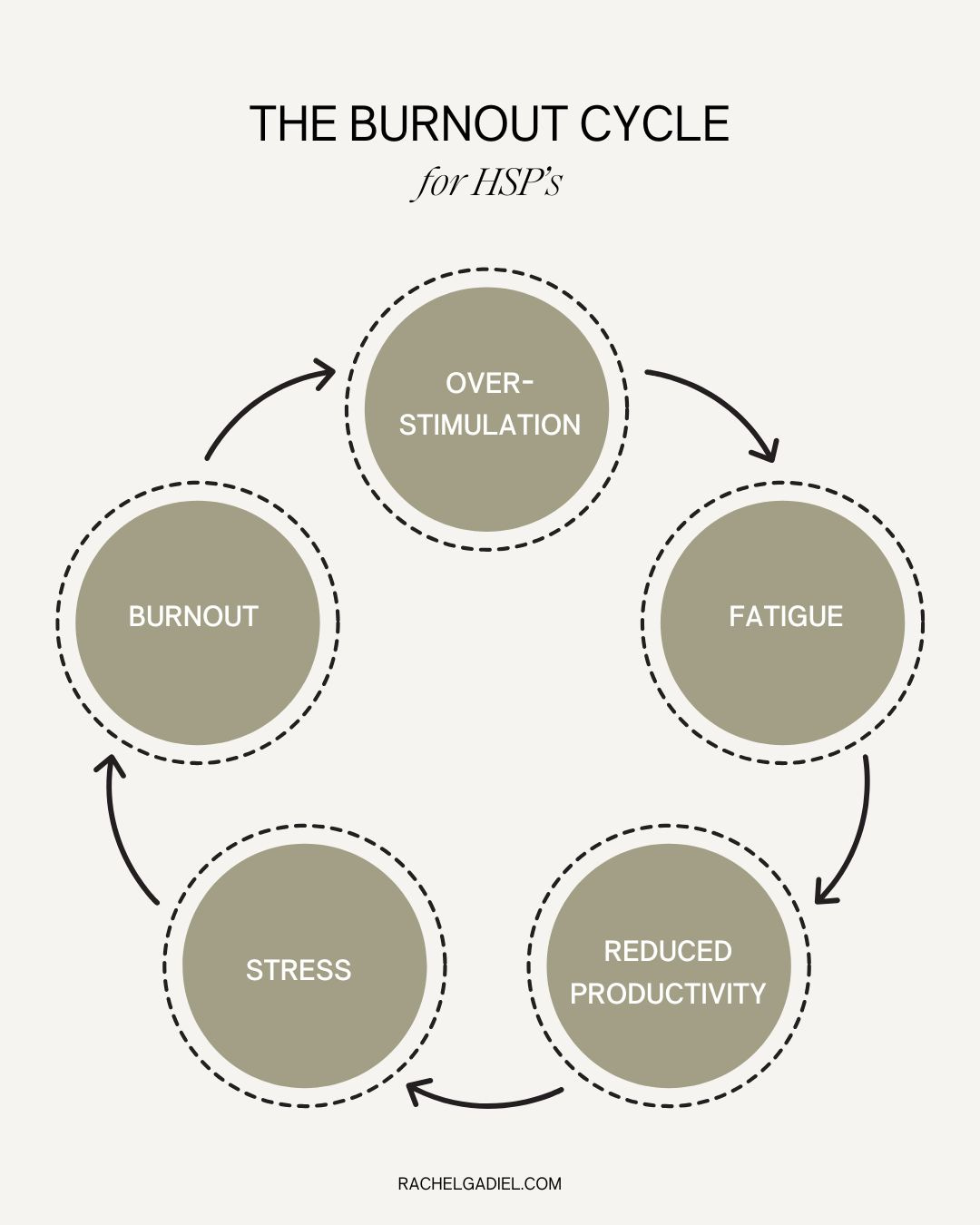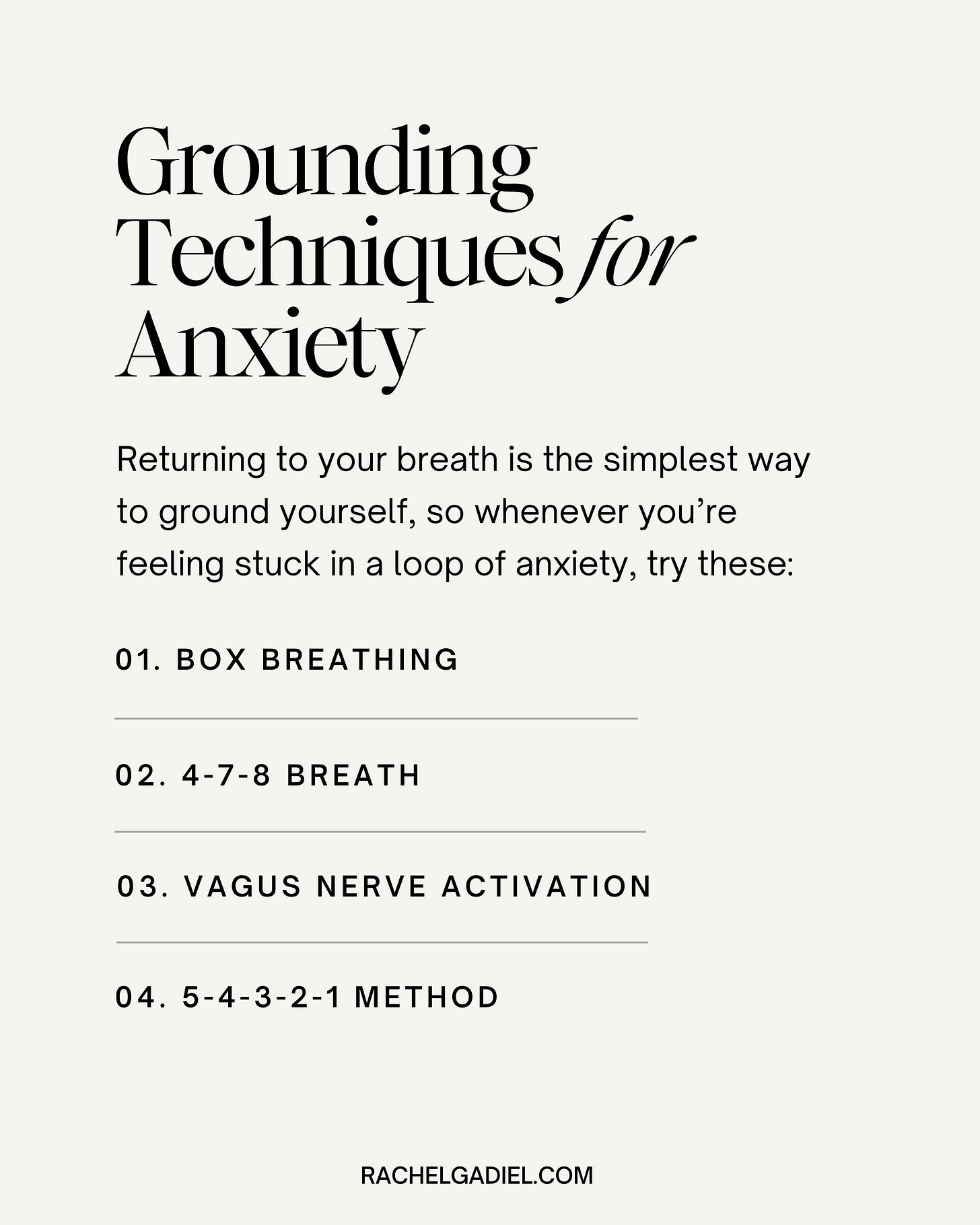How Somatic Tools Help HSPs Manage Energy & Anxiety
I learned the hard way that regulating your energy through the body, not just the mind, isn’t a nice-to-have. It’s a life-altering skill.
I’ve lived most of my life in a state of low-grade anxiety.
It showed up as racing thoughts, shallow breathing, tension in my chest, and a persistent sense that something was wrong - or was about to go wrong. It impacted my sleep, where I’d be lying awake at night replaying conversations, worrying about outcomes, or planning a course of action for every possible disaster. It impacted my relationships as I’d be constantly overthinking everything; and above all it impacted my career.
Each day, I’d keep showing up to work - smiling and going about my business - but underneath, I was stuck in a state of quiet panic.
At the time, I thought this was just “normal.” That it was my natural state of being. But the truth was, I had no idea how dysregulated I really was.
How Anxiety Quietly Impacts Your Work
What I didn’t realise then was that anxiety was seeping into every corner of my career.
It was shaping how I showed up in meetings.
How I second-guessed decisions.
How I overcommitted, overworked, and then burned out, on repeat.
How I said yes when I meant no - because it felt safer than disappointing someone.
I wasn’t making aligned choices - I was making anxious ones.
And I know I’m not alone - studies have found that highly sensitive people are more prone to anxiety, and the rates are even higher among women.
The problem is, this kind of anxiety can become a silent driver of misalignment at work. It disconnects us from our intuition, clouds our thinking, and pushes us to override our energy in order to “keep up.”
And for HSPs, this pressure is amplified. We don’t just feel stress - we internalize it. We process everything deeply. And if our nervous system isn’t regulated, we end up living in survival mode - even in the most ordinary workday.
I learned the hard way that regulating your energy through the body, not just the mind, isn’t a nice-to-have. It’s a life-altering skill.
Discovering the Disconnect
Things began to shift when I started learning about how the subconscious mind works, and its deep connection to the body.
I came to understand that so much of our behaviour isn’t rational - it’s habitual, instinctive, protective, and often rooted in old patterns wired into our nervous system that are designed to keep us safe. I realised that while I had been trying to think my way to safety, my body was still operating from a place of fear.
What became painfully clear was this:
My mind had been in overdrive for years - and I was completely disconnected from my body.
I was overthinking everything. Trying to control outcomes. Staying stuck in loops of anxiety, convinced that if I repeated affirmations, mediated and focused on being positive, I’d feel calm.
But all the mindset tools in the world couldn’t ground me - because my nervous system didn’t feel safe.
The Burnout Cycle for HSPs
What followed was a predictable loop I now see everywhere - in myself and fellow HSPs trying to thrive in a system not built for us:
And the hardest part is this:
When we’re anxious, we push ourselves harder. We try to “fix” ourselves by doing more than we have capacity for, believing that we’re the problem. And in doing so, we override the signals from our body that say pause, rest, breathe.
Thing is, you can’t create calm from a place of panic.
And you definitely can’t make aligned career decisions when your body is in survival mode.
So what actually helps?
This is where somatic tools to self-regulate come in.
Somatic Tools to Self-Regulate & Recalibrate
Since recognising that the key to calm and clarity lies in reconnecting with my body and listening to its wisdom, I’ve focused less on trying to control my mind and instead have shifted my focus to tuning in to asking my body what it needs.
The truth is, you can’t think your way out of overwhelm. You need to feel your way back into safety.
These body-based practices are what helped me break the burnout cycle and start showing up from a place of calm.
These tools have become daily rituals and I use them whenever I feel anxiety creeping in, slowly taking its grip on me. I love having a toolbox of practices I can turn to whenever I feel out of balance, that are simple, gentle, and incredibly effective, and I hope they offer you some relief too.
Grounding Techniques for Anxiety
Returning to your breath is the simplest way to ground yourself, so whenever you’re feeling stuck in a loop of anxiety, try these:
Box Breathing
Box breathing is a simple yet powerful technique that helps regulate the nervous system and restore a sense of calm after stress or overwhelm. This practice can help quieten your racing mind, relax physical tension, and bring clarity and focus back online. These are especially helpful during moments of anxiety and mental fatigue.
How to do it:
Inhale for 4 counts → Hold for 4 counts → Exhale for 4 counts → Hold for 4 counts (repeat 3–5 rounds).
4-7-8 Breath
I love using this simple breathing technique right before sleep - it’s one of my favorite ways to gently self-regulate after a day of overstimulation. The extended exhale helps signal to the nervous system that it’s safe to unwind, slowing the heart rate and bringing the body into a more restful state. It’s a powerful tool for transitioning out of “doing” and back into calm.
How do do it:
Inhale for 4 counts → Hold for 7 → Exhale for 8 counts
Vagus Nerve Activation
The vagus nerve is the longest cranial nerve in the body and a key part of your parasympathetic nervous system, which is responsible for rest, digestion, and recovery.
When stimulated, it sends a signal to your brain and body that says:
“You’re safe. You can slow down now.”
This is incredibly important for HSPs and anyone living with chronic anxiety, because it helps shift your nervous system out of fight-or-flight and into a state of calm.
Practices like humming, singing, or gentle neck massage can help to activate your vagus nerve naturally. They’re fast, effective, and can be done discreetly - and can work perfectly before a meeting, call, or decision that feels emotionally charged.
These science-backed tools help to regulate your nervous system and re-establish a sense of safety in your body.
5-4-3-2-1 Method
This grounding technique is especially helpful when your mind is spiralling or anxiety feels overwhelming. This is a simple tool to reconnect with your body, anchor into the present, and create a sense of calm within the chaos.
How to do it:
Tune into your five senses and notice - 5 things you see, 4 you can touch, 3 you hear, 2 you smell, and 1 you taste.
This will gently shift your attention from racing thoughts so you can return to the present moment.
Body-Based Tools for Regulation
These somatic tools gently guide your nervous system out of anxiety and back into safety. They’re especially powerful when words or mindset shifts aren’t enough - because they work through the body, not just the mind.
Your body holds wisdom. And with the right tools, you can shift from surviving to quietly thriving.
Shaking
Sometimes, stress and overstimulation get stored in the body as physical tension or excess energy. Shaking is a powerful way to release this.
How to do it:
Stand up and gently shake your arms, legs, shoulders, and torso for 30 seconds. You might feel a bit silly - but animals in the wild do this instinctively after stress. It’s how they return to calm. Shaking resets the system and helps clear out the “charge” that anxiety leaves behind.
Butterfly Hug
This self-soothing technique was originally developed for trauma recovery, but it’s incredibly effective for everyday stress and sensory overload.
Cross your arms over your chest so your fingertips rest on your collar bones or upper arms. Tap alternately - left, right, left, right - slowly and rhythmically. Combine this movement with deep breaths.
This bilateral stimulation sends calming signals to the brain and helps you feel grounded, safe, and supported from within.
Hand-on-Heart
Placing your hand on your chest is a gentle way to reconnect with yourself and bring warmth and comfort to your nervous system.
As you breathe slowly, let your hand become an anchor. You could also silently repeat a phrase like:
I’m safe to slow down. I don’t have to rush.
This practice can be especially helpful after a difficult conversation, when you feel anxious or scattered, or as part of a morning or evening ritual.
Cold Water Splash or Holding Ice
Cold activates the vagus nerve and can quickly bring you out of mental spirals or emotional flooding.
Try splashing cold water on your face, holding an ice cube, or running cold water over your wrists.
These techniques create a sensory interruption that brings your awareness back into your body - and can help you feel clear, focused, and steady again within seconds.
Create a Calm Work Environment
Environment is everything for HSPs. It influences our mood, energy, focus, and overall sense of wellbeing. When a space is overstimulating - whether it’s too noisy, cluttered, harshly lit, or energetically chaotic - it’s almost impossible to feel calm or do your best work.
Instead of trying to fix or change who you are, it’s far more helpful to adapt your environment to support your sensitivity.
You don’t have to change who you are. You can change the space around you.
By making small, intentional adjustments, you can create conditions where your nervous system settles, your creativity flows, and your energy is preserved, not depleted.
Try these simple tweaks:
Use warm, soft lighting to gently diffuse brightness and create a more soothing atmosphere - this is especially helpful if overhead lights feel harsh or draining.
Reduce noise in whatever way works best for you: wear noise-cancelling headphones, play calming background sounds, or embrace silence to let your nervous system breathe.
Clear visual clutter from your desk or work area. A tidy, minimal space can help create mental clarity and reduce sensory overwhelm.
Add cozy, calming elements - light a candle, diffuse essential oils, or include soft textures like cushions, rugs, or your favorite throw to bring a sense of comfort and groundedness to your space.
Cultivate Morning & Evening Rituals
Rituals are not about productivity - they're about grounding in your true nature.
For highly sensitive people, how we begin and end the day sets the tone for how we move through the world. Creating soft, intentional bookends around your day helps regulate your nervous system, reconnects you to yourself, and gently shields your energy.
Here are some simple ways you can incorporate these tools into your daily rituals:
Morning rituals to ground & realign
Start your day by tuning inward before the world rushes in. Even five minutes of intentional practice can shift your entire nervous system and help you meet the day with clarity.
Try these gentle practices:
Breath work (1–2 mins):
Try Box Breathing or 4-7-8 breath to regulate your system and bring your mind into stillness before the noise of the day begins.
Gentle stretching or journaling:
Move your body intuitively or write freely to release what’s sitting beneath the surface. This helps you process emotions and enter your day clear and open.
Ask yourself: “What do I have energy for today?”
Not what should I do, but instead: what feels aligned, supportive, and true?
Let your energy - not your to-do list - guide you.
Evening: Reset & Release
Evenings are your opportunity to release any tension, decompress your system, and return to yourself. Without a wind-down ritual, you carry the day’s stimulation into your rest - which keeps your nervous system on high alert.
Try these soothing practices:
Shake off the day:
Gently shake your arms, legs, and shoulders to release residual stress. It’s a simple way to physically let go of what you’ve been holding.
Use a soothing practice:
Try a hand-on-heart pause or 4-7-8 breath to downshift your nervous system and signal that it’s safe to rest.
Create a calm and cozy space:
Dim the lights. Turn off any screens. Play soft music or sit in silence. Light a candle. Let the energy of your home shift with your body to restoration.
If you’re an HSP who’s felt trapped in anxiety and burnout - who feels overwhelmed by the pace of work, who second-guesses every decision, or who feels like you're one step from shutting down - please know this: there is another way.
You’re not the problem.
The way we’ve been taught to work is.
You can’t thrive from a state of anxiety.
But you can build a thriving life and career from a place of calm.
It starts with a breath. A pause. A reset.
And reconnecting with your body, listening to what it needs.
You don’t have to keep pushing through.
You don’t have to keep overriding your sensitivity.
There is a way that honors your energy, your pace, and your truth.
I’d love to hear from you - have you experienced anxiety or burnout in your work?
What helps you reset and return to calm?
When you're ready for the next step…
Need deeper support? Explore 1:1 mentoring for highly sensitive humans ready to move from burnout to alignment.
Learn more →
Launching soon: The Quiet Path, a self-paced audio course for HSPs recovering from burnout and seeking a gentler way forward.
Join the waitlist →









I love that you structured all these somatic practices on this list. I've known most of them, but the way you lay them out is wonderful and easy to remember or have a list to refer to according to situation or time of day.
Thank you for this practical guide. It's weird but reassuring that I've been doing some of these things instinctively without knowing the true benefits - I have been singing recently in the evenings as I find it calms me, and same with the butterfly hug you mention. Thank you so much for this!